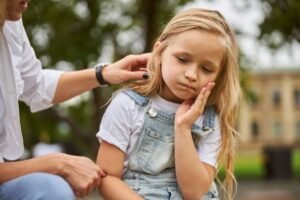Understanding and navigating tooth loss in children is a natural and exciting part of growing up, marking a significant milestone in a child’s development. While it’s a normal process, for some children, the idea of a wobbly tooth or a gap in their smile can be a source of anxiety. At Little Smiles of Beverly Hills, we understand these concerns and are here to help make this transition a positive and fearless experience for your child.
Understanding Tooth Eruption and Child Tooth Loss
Children typically begin to grow their primary (baby) teeth even before birth, with a full set of 20 usually complete by age three. The first tooth often emerges between 6 months and 1 year. Subsequently, the process of losing these baby teeth to make way for permanent adult teeth usually starts around age 6 or 7. The central incisors are typically the first to go, followed by lateral incisors, first molars, canine teeth, and finally, second molars. While molar eruption can sometimes cause discomfort, the natural process of baby tooth loss is generally not painful. Regular dental check-ups are important from the emergence of the first tooth to ensure healthy development and address any concerns regarding tooth loss in children. For more details on the eruption timeline, you can refer to resources like BH LAX Smiles.
Primary Teeth Eruption and Loss Timeline
Here’s a general timeline for when primary teeth erupt and are typically lost:
| Tooth Type | Eruption (Age) | Loss (Age) |
|---|---|---|
| Central Incisors | 6-12 months | 6-7 years |
| Lateral Incisors | 9-16 months | 7-8 years |
| First Molars | 13-19 months | 9-11 years |
| Canine Teeth | 16-23 months | 10-12 years |
| Second Molars | 23-33 months | 10-12 years |
Key Milestones in Children’s Dental Health Regarding Tooth Loss
| Milestone | Age/Event | Importance |
|---|---|---|
| First Dental Exam | By 1st Birthday or first tooth eruption | Establishes a “dental home,” allows for early cavity prevention, and provides parental guidance. |
| Full Set of Primary Teeth | Around 3 years | Essential for proper chewing, speech development, and maintaining space for permanent teeth. |
| Start of Primary Tooth Loss | Around 6-7 years | Marks the beginning of the transition to permanent dentition; crucial for monitoring eruption patterns. |
| Eruption of First Permanent Molars | Around 6-7 years | These are often the first permanent teeth and are critical for chewing; require early attention for sealants. |
| Eruption of All Permanent Teeth (excluding wisdom teeth) | Around 12-13 years | Complete transition to adult dentition; focus shifts to lifelong oral hygiene and orthodontic needs. |
Making Tooth Loss a Positive Experience for Children
Here are some effective tips to help ease your child’s fears and turn their natural tooth loss into a celebrated milestone:
Fostering a Positive Mindset
1. Project a Positive and Calm Attitude
Children often mirror their parents’ emotions. Therefore, by remaining calm, cool, and collected and expressing enthusiasm about losing a tooth, you can signal to your child that this is a normal and exciting part of growing up.
2. Explain the Process Clearly
Furthermore, demystify tooth loss by explaining in age-appropriate terms what is happening. Let them know that baby teeth are like placeholders for the big, strong adult teeth that are ready to come in. Dispelling myths they might have heard about pain or permanence can also help reduce the fear associated with tooth loss in children.
Leveraging Fun and Tradition
3. Involve the Tooth Fairy
Moreover, the Tooth Fairy tradition can add a magical and exciting element to tooth loss. Encourage your child to participate in imagining the Tooth Fairy’s world. For instance, you can create a special tooth pillow, write notes from the Tooth Fairy, or even sprinkle a little “fairy dust” (glitter) to enhance the magic. This tradition can turn apprehension into anticipation regarding their losing teeth.
4. Validate Their Concerns
Conversely, instead of dismissing their fears, acknowledge and validate your child’s feelings. Phrases like, “I know it can feel scary when you lose a tooth, and it’s normal to feel that way. I’m here to give you a hug when you feel nervous,” can be incredibly reassuring. For more tips on calming an anxious child, resources like Rowlett Dental Kids can be helpful.
5. Celebrate Each Lost Tooth
Indeed, make each lost tooth a cause for celebration! You can acknowledge this milestone with a special treat, a favorite meal, or a small reward. This positive reinforcement helps your child associate tooth loss with a sense of accomplishment and growing up.
Educational and Professional Support
6. Read Books and Watch Videos
Additionally, many children’s books and videos feature characters going through the experience of losing a tooth. Sharing these stories can normalize the process and provide a relatable context for your child.
7. Know When to Seek Professional Help
Nevertheless, while natural tooth loss is rarely painful, if your child experiences significant pain or if a tooth is displaced due to trauma, it’s important to contact your pediatric dentist. They can assess the situation and ensure there are no underlying issues. Regular dental visits from a young age also help build a trusting relationship between your child and their dentist, making future dental experiences more comfortable, even with the prospect of losing teeth.
Ultimately, by embracing these strategies, you can transform the potentially scary experience of losing teeth into a confident and joyful journey for your child, celebrating each step toward their permanent smile.
Little Smiles of Beverly Hills is dedicated to providing gentle and compassionate dental care for all children in Beverly Hills. Visit us in Beverly Hills for your child’s next dental check-up, or contact us today!
Q&A about Tooth Loss in Children
Children typically start experiencing natural tooth loss around 6 or 7 years of age.
Natural tooth loss is usually not painful. Some children might experience slight discomfort or soreness as the tooth loosens, but significant pain is uncommon. If your child is in severe pain, it’s best to consult a dentist.
A permanent tooth usually starts to emerge within a few weeks or months after the baby tooth falls out. The exact time can vary for each child and tooth.
Swallowing a baby tooth is generally harmless and common. The tooth will pass through their digestive system without issue. There’s no need to worry.
It’s best to let a loose baby tooth fall out naturally. Wiggling it gently with clean fingers is fine, but forceful pulling can cause pain, bleeding, or even damage to the developing permanent tooth.
Validate their feelings, explain the process calmly, and reassure them that it’s a normal part of growing up. Involving the Tooth Fairy tradition can also make it more exciting.
While genetics play a role, regular dental check-ups allow your dentist to monitor tooth development. In some cases, early orthodontic evaluation may be recommended if space issues are anticipated.
This is called “shark teeth” and is quite common, especially with lower front teeth. Often, the baby tooth will fall out on its own. However, if the baby tooth is not loose, or if the permanent tooth is significantly erupted, it’s a good idea to consult your pediatric dentist.
Baby teeth are extremely important! They help children chew food properly, aid in speech development, and, most critically, hold space in the jaw for the permanent teeth that are developing underneath. Losing them too early due to decay can lead to spacing issues for adult teeth.
The American Dental Association recommends a child’s first dental visit by their first birthday or within six months of their first tooth erupting. This helps establish good oral hygiene habits early and allows for preventive care.
Your Partner in Children’s Dental Health
Navigating tooth loss in children is a significant developmental phase, and while exciting, it can also bring questions and concerns for both parents and kids. At Little Smiles of Beverly Hills, we are committed to making every step of your child’s dental journey a positive one. From their very first tooth to the arrival of their permanent smile, we’re here to provide gentle, expert care and support.
We hope these tips and insights help alleviate any anxieties your child may have about losing their baby teeth. Remember, fostering a positive environment and openly discussing these natural changes can make a world of difference. If you have any further questions or would like to schedule an appointment for your child, please don’t hesitate to reach out to our friendly team in Beverly Hills. We look forward to helping your child maintain a healthy and happy smile for years to come!
Sources
- 4 Helpful Tips for Making Losing Teeth Less Scary – Midland Kid’s Dentist
- My Child Is Afraid of Losing a Tooth! What should I do? – Smiles Dentistry 4 Kids
- How To: Make Losing Teeth Less Scary | Simply Orthodontics – Randolph
- 4 Tips for Making Losing Teeth Less Scary – Simply Orthodontics Nashua
- Loose Tooth Anxiety | Children’s Dentistry Rowlett
- Making Tooth Loss Less Scary | New England Kids
- How to Ease Your Child’s Fear of Losing Their Teeth – Everglades Pediatric Dentistry
- My 6-Year-Old Is Scared of Losing Her Baby Teeth—How Can I Ease Her Fear? – Parents
- Eek! 3 Essential Tips to Make Tooth Extraction Less Scary for Your Child – Wash Park Pediatric Dentistry
- Make Tooth Loss Less Scary for Your Child by Partnering With the Tooth Fairy | Dentists In Chicago, IL – Family Dental of Lincoln
- Eruption of Your Child’s Teeth – BH LAX Smiles
- Children’s Dentistry – Ebrahimi DDS



